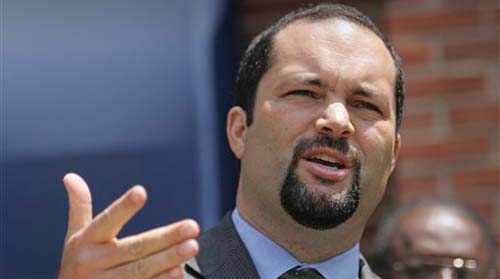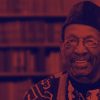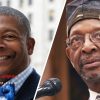New America Media, Commentary,
By Earl Ofari Hutchinson
In a petition circulated online, Change.org minces no words–“NAACP: Hire the First Woman President in the NAACP’s 104 year History.”
Seventy percent of the respondents agreed it is time that NAACP (the National Association for the Advancement of Colored People) elect the first permanent woman president in its history.
The petition and the clamor for a woman to lead the organization came almost within moments after current NAACP President Ben Jealous announced he was stepping down at the end of the year. This is hardly the first time there’s been a clamor and an even louder criticism of the dearth of female leaders at the top of the nation’s major civil rights organizations.
Two things have marked the litany of civil rights organizations past and present. One is that throughout the history of the best-known major civil rights groups–the Urban League, Congress of Racial Equality (CORE), Student Nonviolent Coordinating Committee (SNCC), and of course the NAACP–no woman has occupied the top spot any of them.
The sole exception was in 2009, when the Southern Christian Leadership Conference (SCLC), which in its declining years finally elected the first woman head, Bernice King, Dr. Martin Luther King’s daughter. But that breakthrough was short-lived when King could not reach agreement with the SCLC’s male-dominated board regarding the terms of her presidency.
The second major earmark of civil rights organizations has been the number of prominent women who played pivotal roles in the fight for justice and equality. They are well-known: Rosa Parks, Fannie Lou Hamer, Ella Baker, Gloria Richardson, Dorothy Cotton, Septima Clark, Dorothy Height, to name a few.
These women had to wage two fights. One was for civil rights and one was against the blatant sexism and male dominance among the rank and file and leadership in the civil rights organizations.
The men frequently denigrated and minimized women’s role and importance, or they pigeon holed them into so called women’s roles—typists, phone answerers, general gofers, and just plain flunkies for the men. In some cases, they sexually exploited and abused women.
The most blatant example of this was Black Panther leader Eldridge Cleaver’s frequent admonition that the only place for women in the movement was “prone.” This ignited a firestorm of criticism and condemnation from female Panther members and among women activists in various other civil rights organizations. Although Cleaver took much deserved heat for his insulting and outlandish digs at women, he reflected the quiet sentiment of far too many men that, aside from their views of women, their positions were some of the most advanced, forward thinking and progressive in their social concepts and activism.
The Achilles’ Heel of the civil rights organizations remained the quiet and destructive sexism within their ranks. This history burst into public in the run-up to the 50th anniversary commemoration of the March on Washington this past August. A number of women took dead aim at the march’s 1963 organizers for what they considered the deliberate exclusion of women from a major role in the planning, organizing and deliverance of any of the keynote speeches at the historic event.
Those women didn’t stop with a nostalgic glancing, over-the-shoulder critique of the events 50 years ago. Instead, they openly wondered how much had really changed within the major civil rights organizations today.
Apart from the towering roles that women played in past civil rights battles as activists and organizers, radical women, such as Kathleen Cleaver, Angela Davis and Hamer showed by their courage and example that they could more than hold their own and even surpass most men, including men who were considered the movement leaders, in terms of vision, passion, energy and steel-like dedication to the fight for economic and social justice.
Yet despite the power of their leadership and example, they still had to struggle against marginalization by male leaders. In spite of their prominence and name recognition, they constantly bumped up against the intrinsic and galling reality that when it came to leadership and decision-making in organizations, the hard edge of traditional and ingrained male domination and female marginalization continued to be the order of the day.
While many applauded an Angela Davis and rallied to her defense, she was still seen by many men as a woman first, second and often last, and not as a black leader. Yet, just as in the past, there were powerful examples of women as activists and leaders in the civil rights movement, there are even more women today who are fully capable of being not only the visible face of a major civil rights organization, but one of its leading decision and policy makers as well.
NAACP has legions of women in local decision- and policy-making roles in their various chapters. Any one of them could step into the top presidential spot. There are also prominent women outside the organization that BlackAmericaweb.com named, who could assume the president’s mantle.
Among them are Stefanie James Brown, former NAACP youth and college director; Aisha Moodie-Mills, senior fellow at the Center for American Progress; Sherrilyn Ifill, president and counsel-director of the NAACP Legal Defense Fund.
Appointing any one of them to head the organization would signal that the NAACP has shattered the glass ceiling. It would send a powerful message that the organization regards the fight for gender equality and against sexism as being equally potent and compelling as the historic and continuing fight for racial justice and equality.
NAACP has a golden opportunity to open the door of its male-only room at the top to women. It’s an opportunity that it and no other civil rights organization purporting to call itself a champion of civil rights should blow.












![AEO, Ras Kass, Nkechi Taifa, Kymrence Young & Tricky Trev.) (feat. Young RJ [Slum Village], Ras Kass, Nkechi Taifa & Kymrence Young)](https://ibw21.org/wp-content/uploads/2024/12/organizing-anthem-AEO-Agitate-Educate-Organize-1600x900-1-100x100.jpg)


